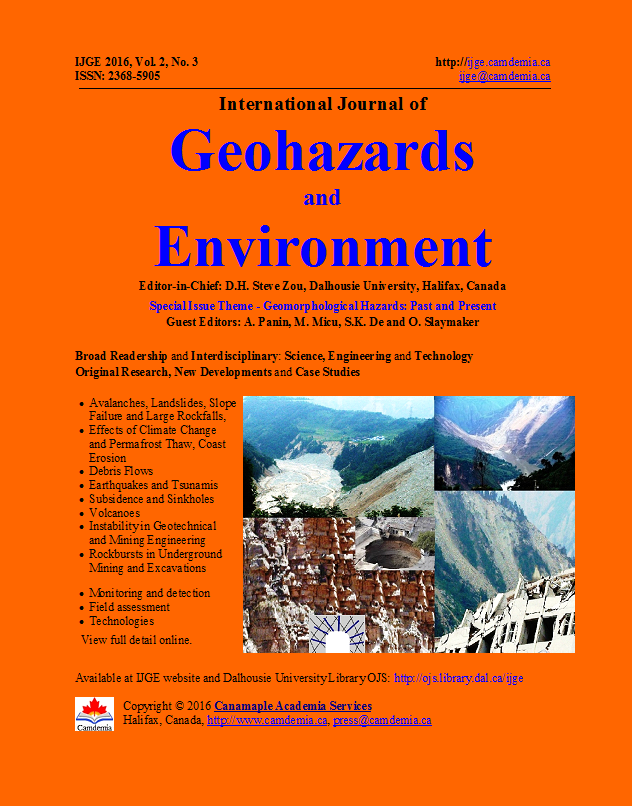Geophysical Investigation and Management Plan of a Shallow Landslide along the NH-44 in Atharamura Hill, Tripura, India
DOI:
https://doi.org/10.15273/ijge.2016.03.013Keywords:
landslide, instability, hazard, geophysical investigation, human interferenceAbstract
In any effective landslide hazard mitigation plan, in-depth knowledge about the causes of instability is required. Consequently, it is essential to study geological, geotechnical, meteorological and anthropogenic factors that influence the landslide. For the present study a geophysical investigation has been carried out on a large landslide, on the slopes of Tertiary siltstones, mudstones, shales and sandstones at Atharamura Hill, Tripura. Different techniques have been used, including measurement of micro-slope using Total Station, clinometers and the LISCAD software for terrain modeling and determining the total volume of the material displaced and total area affected by landslides and analysis of soil properties to understand the present condition of the scarps. Results obtained through field investigation and laboratory testing revealed that the underlying cause of the slide could be (a) the adverse geological formation with unconsolidated sandy materials and occasional intersection of silt or clay layers, (b) the hydrological condition with continuous seepage through fractures, and (c) cutting of hill slopes for reconstructing and widening of the road (NH44). This latter anthropogenic influence has been triggered by an intense precipitation event during the monsoon season.Downloads
Issue
Section
License
Copyright, Terms and Conditions
The International Journal of Geohazards and Environment (the Journal) is published by Canamaple Academia Services (the Publisher) online with open access, under a Creative Commons Attribution-Noncommercial license (CC-BY-NC) (http://creativecommons.org/licenses/by-nc/4.0/). Authors (the Authors) submitting papers (the Work) for publication in the Journal automatically agree to the following terms and conditions.
1. Under the license (CC-BY-NC), Authors give permission for others to share and reuse the Work, as long as the original source and author(s) are properly cited (i.e. a complete bibliographic citation and link to the Journal website) and the material is not used for commercial purposes. Any sharing or reuse must however indicate the original CC-BY-NC license terms of the work.
2. Authors transfer and assign to the Publisher all copyright in and to the Work. However Authors retain all proprietary rights except the copyright, related to the Work and also retain the rights a) to use, reproduce, distribute, and publicly display the Work in any medium in connection with the Authors‘ academic and professional activities, such as teaching, presentations and lectures, b) to create derivative works from the Work and to make full use of the Work in future research and publications, c) to authorize others to make any non-commercial use of the Work, d) to make both the pre-published and final-published versions available online in institutional and/or disciplinary repositories or on their own websites with a citation and link to the original paper published in the Journal.
3. Authors warrant that the Work is their original work, it is not copied from anywhere or anyone else, they are totally responsible for the authenticity, originality, validity and accuracy, and the facts and views are their own, that the Work contains no matter which is defamatory or infringes any literary or proprietary rights, intellectual property rights, or any rights of privacy, and that the Work has not been simultaneously submitted to any other journals or publishers. Authors further agree that their manuscripts whether accepted or rejected will not be returned and the rejected manuscripts will be disposed at the journal editor's discretion.
Disclaimer: The Publisher, the Journal and the editors accept no responsibility for statements or opinions expressed by authors. Use of information and materials in the Journal is the sole responsibility of users.


